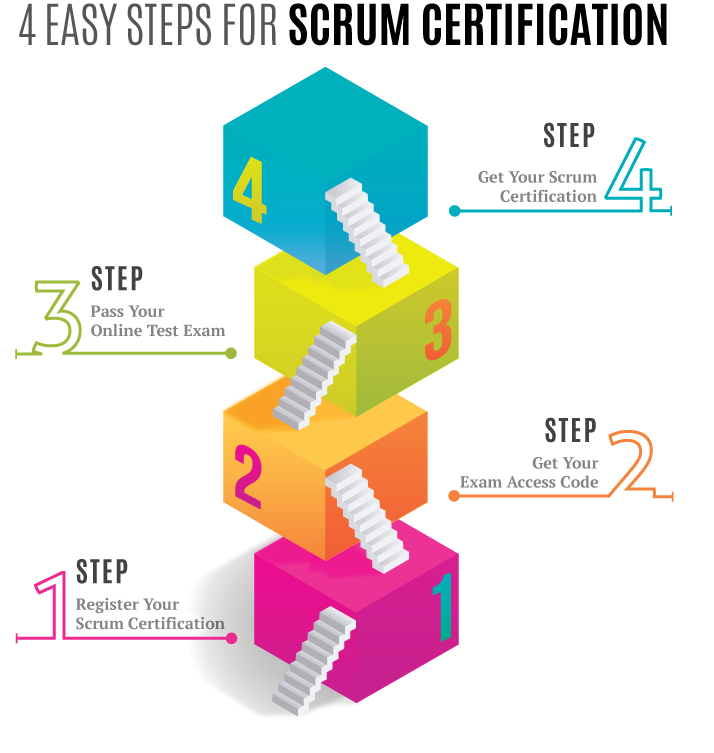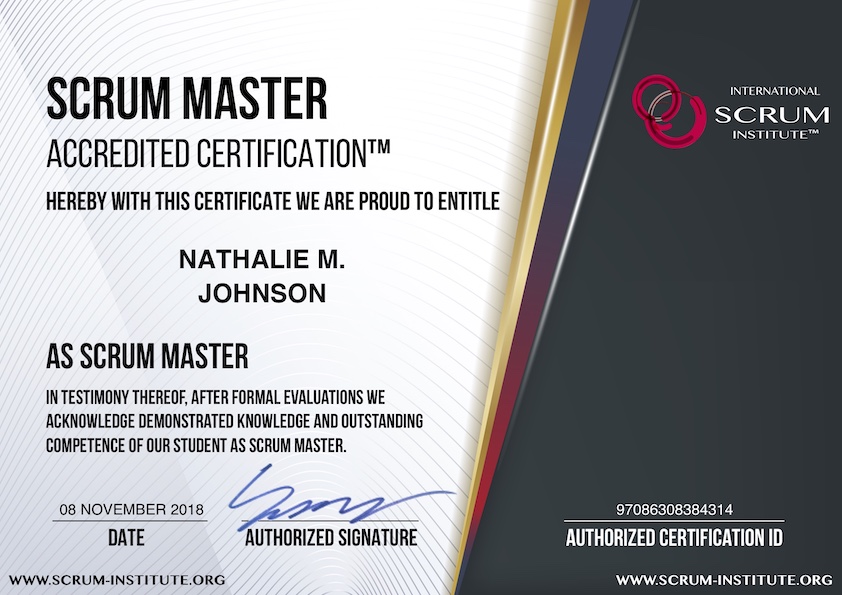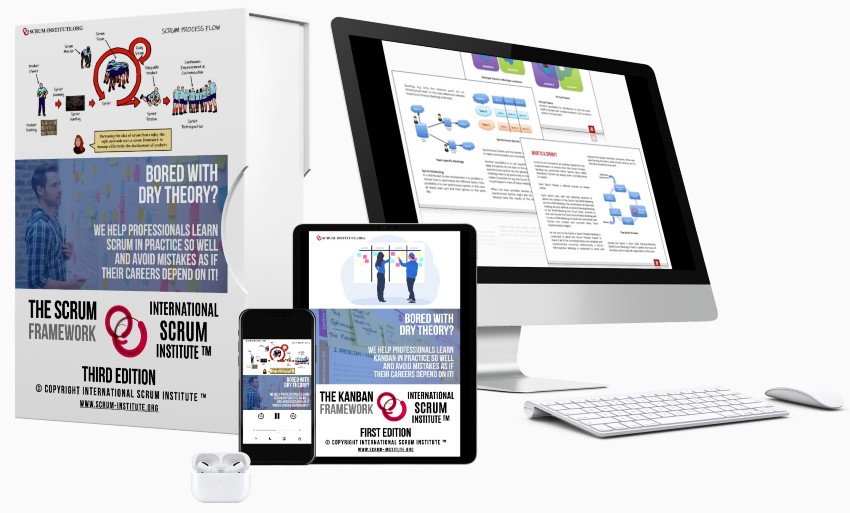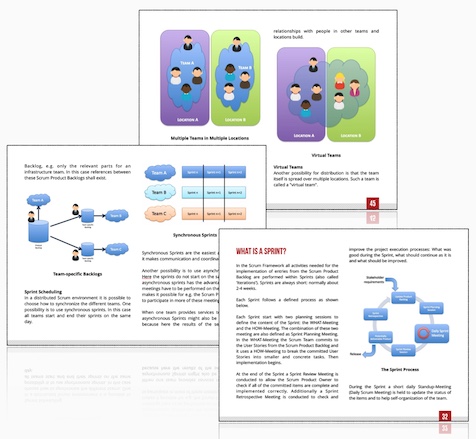Scrum Team and Scrum Roles in Agile Project Management [The Ultimate Guide]
A Scrum team in agile product delivery environment is composed of individuals with specific roles and responsibilities. These roles typically include a Scrum Master, Product Owner, and Development Team. The Scrum Master facilitates (Top 10 Scrum Master Qualities With Team Skills) the team's adherence to Scrum principles and practices, while the Product Owner represents the interests of the business and organization.
What is a Scrum Team, and How is it Structured?
Scrum teams, typically consisting of cross-functional members, collaborate closely to deliver high-quality products in short iterations called sprints. The scrum framework promotes transparency, inspection, and adaptation in an organization (aka self-organization), allowing teams to continuously improve and respond to changing customer needs.
At a high level, project management in the digital era isn't merely about the hours staff pour into meticulous planning, but rather the estimation of effort and the velocity of their approach. These days, universities and professional trainers are increasingly focusing on methods that accelerate productivity while maintaining quality. Of course, with respect to specific methodologies gaining prominence, numerous case studies and retrospective evaluations highlight Scrum- a subset of Agile methodologies. This comprehensive guide, filled with valuable content, plunges you headfirst into the orchestration of Scrum foundation and sub-teams, thereby empowering you as a scrum professional to navigate the realm of Agile project management with finesse. If your organization believes in speeding up product increments without compromising quality and fostering a commitment to efficiency, brace yourself for a thrilling dive into mastering Scrum Teams - your key to unlocking uncharted potential!
In the world of Agile, a Scrum team is a cross-functional group consisting of various staff, each with specialized titles including a Scrum Master, Product Owner, and Developers. These self-managing sub-teams are responsible for all product-related activities from developing features to managing the product backlog. They work collaboratively in short iterations called Sprints to deliver incremental value to users. Interactions within these teams are key to success, and it is recommended that Scrum teams ideally have 10 or fewer members to maximize communication and efficiency. Essential ceremonies and periodic reviews provide a platform to ask questions and receive feedback.
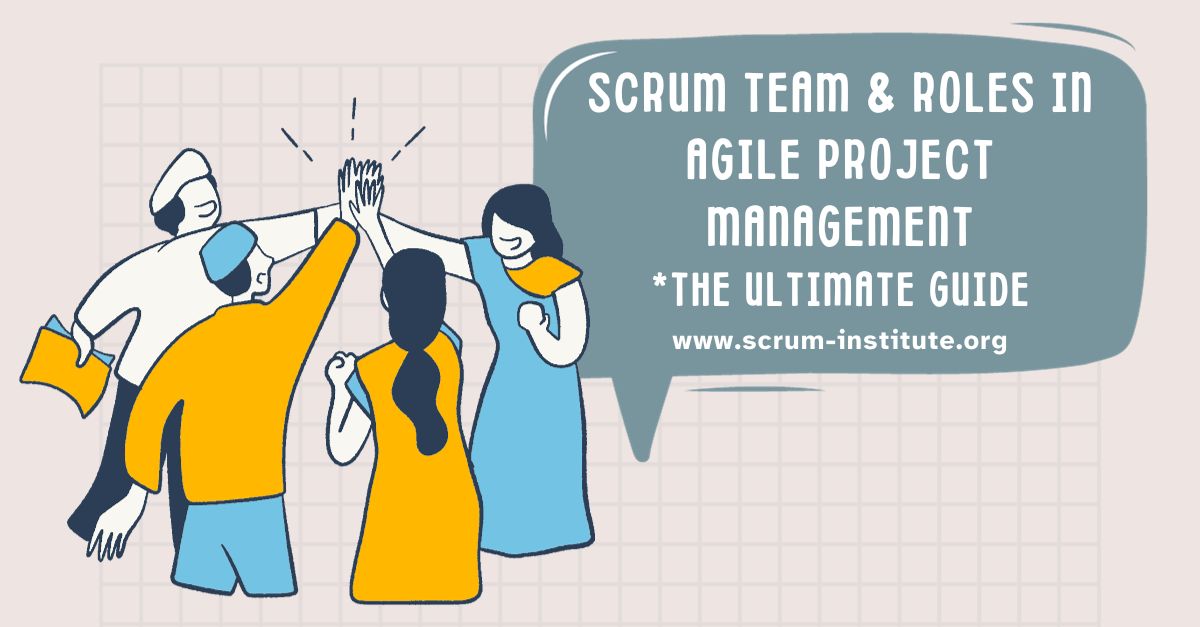 Scrum Team and Scrum Roles in Agile Project Management
Scrum Team and Scrum Roles in Agile Project Management
Overview of Scrum Teams
As learned in many universities specializing in project management, Scrum is an Agile methodology used for successfully managing complex projects. It employs a team-based, iterative approach to developing and delivering software efficiently. A critical element of the Scrum methodology is the Scrum Team, which consists of three specific accountabilities: Developers, Product Owner, and Scrum Master. (See our Scrum Example) The development team consists of individuals responsible for creating potentially releasable increments of software at the end of each sprint. The commitment of the Product Owner is crucial in maximizing the value of the product and ensuring that the development team understands what needs to be delivered. Finally, the Scrum Master supports and coaches the Scrum Team on how to perform optimally and adheres to Scrum values. These role definitions contribute to the success of Agile projects and organization.
If we borrow an analogy from rugby, think of a Scrum Team as a team setting out to score a try. The Development team, like forwards, does much of the heavy-lifting, pushing hard towards the try line until their objective is met. The Product Owner is like a nimble scrum-half, continuously assessing play dynamics and the product backlog, and anticipating moves before they happen. Finally, the Scrum Master acts like an experienced coach, facilitating his sub-teams on optimal performance when executing their game plan. Together, these roles complement each other in achieving set objectives efficiently through constant interactions and commitment.
Hence, it's clear that without an effective Scrum Team in place, or a thorough understanding of its function, successfully implementing agile practices can prove futile.
With well-rounded knowledge of what makes up a good Scrum Team, acquired through our rugby analogy earlier, let's delve deeper into understanding the crucial facets of its structure. In this space, a commitment to efficient interactions and open communication is paramount.
Structure of Scrum Teams and Scrum Organization
According to Agile principles used in Scrum methodologies, cross-functional teamwork is fundamental in guaranteeing successful development by agile teams. This is possible only when the team members, equipped with a clear understanding of the Scrum methodology, work in tandem to solve complex problems.Therefore, the ideal size of a Scrum team ranges from 5-10 people representing different specialties ranging from development to quality control and subject matter experts. In a business context, these teams are akin to a microcosm of a company's employee structure working towards common goals. Acting like mini businesses within the organization, they work on finding answers to software development problems, bringing their expertise together to deliver high-quality services and organization.
However, while larger teams might seem like an attractive alternative based on the potential benefits mentioned earlier, research shows that they eventually lead to more significant obstacles than gains over time. One needs to consider the level of complexity, by definition, embedded in scrum roles and interactions required when deciding on team size, and the things that could complicate team dynamics, such as leadership support, or lack thereof.
| Team Size | Pros | Cons |
|---|
| Scrum Teams of 10 members or less | Agile, quick decision making and minimal bureaucracy, more accountable and focused teams. Better team dynamics, no sub-team silos. Faster delivery and real-time feedback and productive organization. | Minimal communication barriers, limited internal expertise per skill sets that might slow-down delivery due to shared responsibilities between team members. High workload strain on team members. |
| Larger Scrum Teams of 10 members or more | Enhanced diversity of perspectives and skills, more scope for experimentation and quicker feedback loops when breaking down tasks during grooming meetings, easier to engage customers in the product development cycle. Allows for synchronous, more substantial collaboration compared to smaller groups. Improved coordination through sub-team allocation. Optimized use of tools, equipment or facilities/resources across numerous specialties within a single team. | More personal conflicts can arise with large groups as individuals may disagree at some point during agile development phases due to different perspectives or opinions. Time-consuming scrum activities such as stand-ups usually take longer than expected duer to the large group size. Can lead to delays due to long meetings and sub-optimal agile practices can lead to disbelief towards its structures in general. |
To put in perspective, think of it like steering a boat; larger boats require greater amounts of energy and resources to maintain mobility or change direction compared to smaller vessels that can quickly navigate rough waters. The same principle applies to managing a Scrum team with its unique roles for leaders. Just like studying from books or taking practice tests to improve one’s skill, businesses often stand by the fact that smaller, more committed sub-teams, under the right leadership support, are often more successful at managing their product backlog and delivering high-quality software efficiently. Consequently, when forming a suitable Scrum Team set-up, considering a "less is more" approach can be the game-changing strategy your organization needs to foster a healthy work environment that promises quick turnaround times of deliverables without compromising on quality.
As one of the core tenets of agile methodology, self-management is an essential aspect when it comes to Scrum teams. This principle forms the crux of the scrum framework. In short, self-managing teams hold themselves accountable for their tasks and ensure productive team dynamics within the project. Here, professionals in Scrum teams, adequately guided by a qualified trainer, have the autonomy to make key decisions concerning task prioritization, sprint duration, and daily stand-up meetings.
Let's take an example: Developers in Scrum teams can choose their preferred coding language or specific development tools that aid collaboration and productivity. Such measures lead to a sense of ownership and empowerment which positively impacts employee engagement metrics. Moreover, self-management allows individuals from diverse backgrounds to utilize their unique skill sets in ways that traditional management and even some leaders wouldn't encourage.
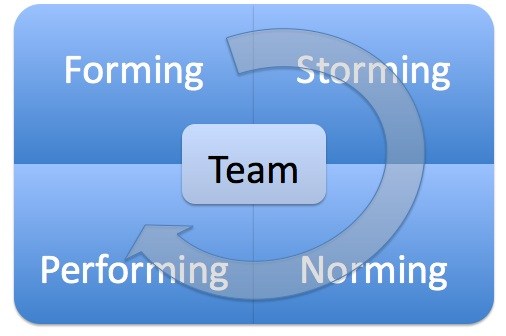 Tuckman Model
Tuckman Model
Scrum Teams and Agile Self-Management
However, with freedom comes great responsibility — self-management necessitates discipline, accountability, and continuous learning from partners training companies. As such, it's important that there's sufficient trust built within the team and a shared understanding of work ethics.
Now that we understand what self-management entails let's delve deeper into specific scrum roles within Scrum teams, and other things which contribute to team's productivity.
The three primary roles within a Scrum team are Scrum Master, Product Owner (PO), and Developers.
Defining Roles within Scrum Teams
Scrum Master (SM): The primary function of the Scrum Master is facilitation – ensuring that the team adheres to the principles of agile methodology by following structured processes such as time-boxing sprints and daily stand-up meetings. They are like the librarians of the business world, keeping everyone aligned and ensuring no problem is left unresolved.
Product Owner (PO): The Product Owner channels the expectations of stakeholders, customers, and leaders towards a product vision from customer requirements that aligns with business value streams. They serve as the link between the business and development services, making sure the team stays goal-oriented.They act as the pivotal conduit of communication between stakeholders, clients, and developers, all while functioning as the main decision-maker for product features. This often includes considering data on sales, costs, and operations to make informed decisions, ensuring that the service provided is of the highest quality while being cost-effective.
Scrum Team Members (Developers): The Developers (aka Scrum Team Members) are the key implementation stakeholders within the Scrum team, significantly contributing to its operations, and represent cross-functional roles under the guidance of a qualified and experienced trainer. Their mission is to execute project sprints effectively and keep costs low. In pursuit of this mission, they are steadily improving the work process. Ideally, each developer should have a diverse range of skills. These skills should encapsulate their design, coding, testing, and business experiences, including managing costs and using data to drive sales. Scrum trainer courses encourage developers to enhance these skills and service to the clients, and periodically taking a class in the latest UX practices or advancing to Scrum Master II can provide a substantial boost in their efficiency and money-saving operations.
Their working relationship is akin to a composer-conductor duo in an orchestra; while one, the Scrum trainer, is responsible for shaping the piece of music or project using sales data and cost constraints, the other, the developer, ensures flawless execution by guiding each instrument or task in harmony. Using skills acquired from scrum masters courses, they can ensure each project detail is adhered to meticulously, further enhancing the service to their clients.
More importantly, however, it’s essential to understand that Scrum teams embrace a collective accountability model, where success or failure within a project isn't attributed to one role alone. The harmonious collaboration between these roles, nurtured by a shared mission and operating within cost limitations, paves the way for fluid communication, continuous improvement, and innovation.
Having understood specific roles within the Scrum team let's explore how agile teams manage both large and small projects as we further unravel The Ultimate Guide to Scrum Teams in Agile Project Management. This will include discussion on how to optimize operations, improve service quality, and drive sales while saving money.
Developers play an integral role in the Scrum process. Leveraging knowledge received from classes such as Scrum Master II, They are the ones who transform user stories into working product increments, and their labor is a substantial cost in the overall operation, thereby facilitating the effectiveness of the entire Scrum framework.
| Role | Responsibilities |
|---|
| Scrum Master | Facilitation of team processes, safeguarding against external influences |
| Product Owner | Creating product vision based on customer requirements aligning with business value streams |
| Scrum Team Members (aka Developers in self-organizing Technology Businesses) | Implementing project sprints, continual process improvements leveraging diverse skill sets |
Developers and the scrum product owner work collaboratively within the Scrum team, making sure that all features are fully formed before moving on to the next stage of development. Taking part in scrum trainer seminars, analyzing sales data, and sharing experiences with a wider trainer community can enhance their skills and understanding of scrum practices while improving their service to their clients.
One defining characteristic of developers in Scrum, nurtured by a strong affinity for continuous learning in scrum masters courses, is their being cross-functional. Possessing multiple skills, including analyzing sales data, managing costs, programming languages, testing, and designing interfaces, lends developers a unique ability to approach issues from various angles, resulting in innovative and effective solutions.
Developers in Agile Scrum Development
Scrum emphasizes accountability and collaboration; thus, developers must continuously update each other on progress. Regular daily meetings, similar to a class structure, ensure updates on tasks and impediments faced while highlighting areas for support from other team members, ensuring a consistent flow of information. These meetings also help in tracking costs and assessing how their service is impacting sales and client satisfaction.
For instance, a developer could be stuck in debugging code for a bug that has been impeding their progress for 2 days. A teammate, likely a more experienced developer or one who has been in similar situations, could have garnered insights from the Scrum Master II course that could assist with such issues. These insights can help save time, money, and improve overall operations.During sprint planning sessions, developers work alongside Product Owners and Scrum Masters to articulate specific items approved for development during sprints. These meetings evoke the feel of a productive class where the scrum product owner, developers, and scrum master are all students learning, collaborating and taking steps together in the fascinating realm of innovations scaling scrum. LinkedIn can also serve as a knowledge hub for discovering growth ideas for scaling these methodologies.
Subsequently, the Developer will then estimate the amount of work needed per task to achieve the feature scope, while also considering potential risks that may impact these tasks. This balance between optimizing for efficiency and recognizing complexity, as required by each task such as time usage, is a typical takeaway from the scrum masters courses and also plays a key role in ensuring consistent revenue growth.
Ultimately, developers deliver a potentially releasable product increment at the end of every sprint. This consistent output, backed by skills acquired through scrum trainer classes, helps to keep stakeholders engaged by showcasing the perceived value offered by the project incrementally over time, making it a sustainable source of revenue and growth.
In the Scrum process, one crucial thing is having roles that align with particular functions rather than planned hierarchical rules typical in other project management methodologies. Inputs from the scrum trainer community and learnings from courses like Scrum Master II available on platforms like LinkedIn play a vital role in enhancing such role alignment. Attuned to the value practice of representing a customer's interests, the Product Owner and the Scrum Product Owner have agile leadership and deep product management skills. Both of them are jointly responsible for achieving optimal value within every Sprint cycle. The PO ensures that value realization happens through iterative increments until completion of the agreed-upon scope.
Developers and the scrum product owner work collaboratively within the Scrum team, making sure that all features are fully formed before moving on to the next stage of development. Taking part in scrum trainer seminars, analyzing sales data, and sharing experiences with a wider trainer community can enhance their skills and understanding of scrum practices while improving their service to their clients.
Working in harmony with a software developer and the Scrum Product Owner, the Scrum Master is an agile leadership figure, facilitating rather than dictating the software development procedures, focusing on maximizing team performance efficiency by enabling flexibility to adapt to challenges, monitoring progress, and facilitating the various Scrum events and activities such as stand-ups and sprint reviews, thereby demonstrating agile leadership value linked with effective scrum practices.
SM ensures compliance while ensuring that the team understands Scrum values, practices, and the concepts of the framework. Both roles are crucial for effective communication within a Scrum team as they enhance collaboration among stakeholders to achieve the project goal optimally. In order to facilitate this, some Scrum Masters and Product Owners even enrol in leaders courses on LinkedIn to make themselves more knowledgeable and acquire specific certifications, thereby empowering them to guide their teams more effectively.
The Scrum Master and Product Owner
To ensure effective communication within a Scrum Team, we must examine how both roles collaborate and communicate effectively, a pre-requisite in this product management setup that necessitates the continual growth of interpersonal skills and knowledge through innovations in scrum training and education.
Effective communication is the backbone of agile project management and crucial for the smooth functioning of Scrum teams. Each member must work cohesively to achieve successful outcomes, and this cannot happen without consistent communication. A well-communicated idea can avoid misunderstandings, delays, and ultimately re-improve the quality of your product, thereby reducing the risk of time and resource wastage.
The first step towards ensuring this is to establish clear channels of communication, thus fostering an environment conducive to the successful scaling of scrum methodologies across teams and organizations.
The second step is to establish clear channels of communication. It would be best if you had a shared platform – like Jira or Asana – that acts as a point of reference to follow up on task progress and identify issues that need immediate attention. This software-enhanced approach allows all members, including software developers, to see what's happening in real-time, harnessing the capabilities of technology to make it easier for everyone to stay informed and responsive. This active participation aids product delivery through facilitating quickly resolved challenges.
Take, for instance, a situation where a software developer finds an issue while developing the product, working with the product owner will require effective and constant communication throughout the process to ensure all key features are being attended to. Recently, an article on our site attributed the success of such methods, including agile leadership principles, to the guidance offered by Ken Schwaber, a co-creator of Scrum.
- The State of Agile Report found that 58% of organizations had adopted agile practices (like scrum) in their project management.
- The same report discloses that teams adhering to the recommended size of scrum teams (less than 10 members) were more likely to have a higher success rate in project completion.
- Research published in the Journal of Systems and Software in found that Scrum teams' efficiency significantly increased when they managed to limit work-in-progress items and focus on completing tasks before starting new ones.
Effective Communication in Self-Organizing Scrum Teams
Secondly, teams should schedule frequent meetings that allow members to discuss current tasks underway, challenges or roadblocks encountered along the way, and status updates on each milestone achieved. Daily Stand-ups (15-minutes meetings held every day), which are intrinsic to the value practice of agile leadership, are also essential for keeping a pulse on any issues affecting deliverables.
Take, for instance, a situation where a developer finds an issue while developing the product, working with the product owner will require effective and constant communication throughout the process to ensure all key features are being attended to. Recently, an article on our site attributed the success of such methods, in part, to the guidance offered by ken schwaber, a co-creator of Scrum.
Secondly, teams should schedule frequent meetings that allow members to discuss current tasks underway, challenges or roadblocks encountered along the way and status updates on each milestone achieved. Daily Stand-ups (15-minutes meetings held every day) are also essential for keeping a pulse on any issues affecting deliverables.
Lastly, creating an open culture within Scrum Teams encourages continuous feedback from team members, which would facilitate improvements in areas experiencing challenges in future Sprints. By giving and receiving feedback constructively and regularly fosters better relationships between team members.
With effective communication established within the Scrum Team structure let's consider decision-making processes in Scrum.
Scrum Teams operate under shared accountability, meaning each member has an equal say in determining what gets added to the Sprint Backlog. As such, Scrum promotes collaboration among all team members, bolstering their capabilities and empowering them to participate in the decision-making process freely.
Effective communication is crucial for the success of agile project management and Scrum teams. Clear channels of communication should be established, using shared platforms like Jira or Asana, to keep everyone informed in real-time. Frequent meetings, such as daily stand-ups, allow team members to discuss tasks, challenges, and milestones achieved. An open culture that encourages continuous feedback fosters better relationships and facilitates improvements in future sprints.
Decision-Making Processes in Cross-Functional Scrum
However, there are specific guidelines to follow when making team decisions. Firstly, teams should seek consensus whenever possible. This means that before final decisions are made, everyone needs to agree on the proposal presented.
Think of it like a ship where everyone's input is taken into account before deciding on stormy weather detours or necessary repairs.
If one member disagrees with a decision, the rest of the team should work with them to ensure their reservations are clarified and addressed. However, getting consensus doesn't always mean that every single person has to be onboard; rather, it refers to finding common ground that the entire team can live with comfortably.
Secondly, if consensus cannot be reached — and only in extreme cases — then voting becomes an option. Each member would cast their vote and only when there's a clear majority will that particular direction be adopted.
It is Important to highlight that as Scrum is meant to be self-organizing, decision-making authority ultimately rests upon the team as a whole. Their success rests on involving stakeholders who contribute valuable insights in sprint reviews and retrospectives needed for future planning.
Consensus in Scrum teams refers to the general agreement of all team members regarding specific actions, processes, and decisions related to the product development process. This agreement is reached through transparent communication channels that allow all team members to express their opinions and ideas without fear of retribution or judgment.
Consensus in Scrum Teams
Scrum team consensus is not only essential but also mandatory in Agile project management. All team members must agree on the work to be done, how it will be done, and the order in which it will be completed. This agreement helps ensure that everyone pulls in the same direction towards achieving the goal. In essence, all team members are engaged in the decision-making processes, vital for consistent product delivery.
For instance, imagine that a company wants to develop a new software feature. The product owner defines this feature as a high priority task, which should be completed within two sprints. During sprint planning, the developers propose an alternative solution that could deliver even more value than the original plan, but with added complexity. After careful discussion and collaboration with all team members, they decide to pursue the alternative solution since they all agree it will add significant value to the final product.
As such, consensus in Scrum teams promotes cooperation and unity among team members and facilitates faster progress towards project objectives. It also enables trust among team members and ensures that no individual has more power or influence than others, leading to a balanced power structure that promotes effective decision-making.
With consensus defined let's now look at value delivery and its role in Scrum.
Value Delivery in Scrum Framework
Value delivery is one of the most critical aspects of Agile project management methodologies; it drives project success by ensuring that development efforts align with company goals and customer needs. When it comes to value delivery within Scrum teams, there are two crucial aspects: delivering value incrementally during sprints and delivering shippable features at the end of each sprint.
Sprint planning meetings help decide on what items can be completed during sprints, and requirements defined by the product owner are leveraged to define value. Each increment of value is an opportunity to gain customer feedback and continuously improve the end-product.
For instance, consider a hypothetical scenario where the Product Owner has identified three critical features that will enhance the user experience within the software. The development team then decides to deliver these features in three consecutive sprints, with each sprint delivering a usable and valuable portion of the overall feature. This approach ensures that customers receive new and improved functionality every few weeks, allowing them to provide prompt feedback on each release incrementally.
Value delivery promotes transparency between customers and development teams, allowing for prompt feedback on increments of value delivered. It also increases customer satisfaction since they receive valuable functionality upgrades frequently instead of waiting for larger releases.
Working in Sprints
One of the defining characteristics of Scrum Teams is their emphasis on working in sprints. Sprints are distinct time-bound periods that enable teams to accomplish short-term goals while constantly improving the product. Typically, they last anywhere from one to four weeks, with two weeks being the most common duration.
During a sprint, the Scrum Team collaborates to achieve a specific set of goals that contribute to the overall completion of the project. Sprint planning sessions allow team members to discuss and prioritize the tasks at hand. A sprint backlog is then created to outline what work will be done during the sprint.
In essence, sprints allow for incremental development and iterative improvement, preventing long-term investment in a plan that may not ultimately meet stakeholder needs.
At the end of each sprint, teams hold a review meeting, where they showcase any completed goals from the previous iteration. This allows for stakeholders' feedback on how the project is progressing and whether any changes need to be made moving forward. Through this frequent feedback loop, teams can adapt and improve quickly without losing sight of their ultimate goal.
Customer Feedback and Adaptation
As mentioned previously, customer feedback plays a crucial role in Scrum Teams' Agile Project Management process. The Scrum Team tries to get as much feedback as possible from customers through reviews at the end of each sprint or during other product demonstrations.
By gathering consistent and real-time customer input, Scrum teams can quickly adapt products according to customer requirements rather than assuming what might be best for them.
One failure mode for companies is when different departments (e.g., developers, product owners) create solutions based on their assumptions without validating with actual customers.
Scrum teams focus their attention on customer satisfaction by promoting collaboration between cross-functional teams throughout projects - allowing for quick delivery cycles that emphasize getting live user feedback ASAP. By doing so early on, the development cycle becomes more prepared to account for customer feedback in future sprints. This allows them to pivot or change direction accordingly.
Challenges of Larger Scrum Teams
One of the primary challenges a Scrum Team faces is staying focused on producing high-quality work while committing to deliverables. The number of people in a team can affect workflows and communication across the team, leading to longer meetings and personal conflicts that can hamper progress. In larger teams, members can struggle with aligning goals and achieving consensus, which results in less time spent on delivering value to customers.
For instance, having 20-30 people in a Scrum team means that communication becomes complex, which affects psychological safety, willingness to share ideas and concerns or respond honestly during reviews. Members can become hesitant to interact with each other, diminishing their ability to collaborate effectively. The result can be more time spent handling interpersonal conflict rather than focusing on producing quality work.
This complexity reduces the project's efficiency due to the increasing lines of communication creating silos and members struggling with handling different roles without coordination. Research has shown that having fewer than 10 people in a Scrum team results in increased throughput and reduced carryover work. This size is optimal for carrying out planning and daily stand-up meetings.
Self-organizing teams are essential in agile environments where command hierarchies do not fit. Establishing separate feature teams within larger squads is one way of breaking down projects further into smaller subgroups to achieve agility. Having an optimal group size improves delivery rates by enabling close collaboration among members who have complementary skills.
There is no one-size-fits-all approach to working with Scrum Teams; however, there are some practical tips for managing larger teams effectively, such as identifying team roles clearly and providing support systems to foster open communication channels.
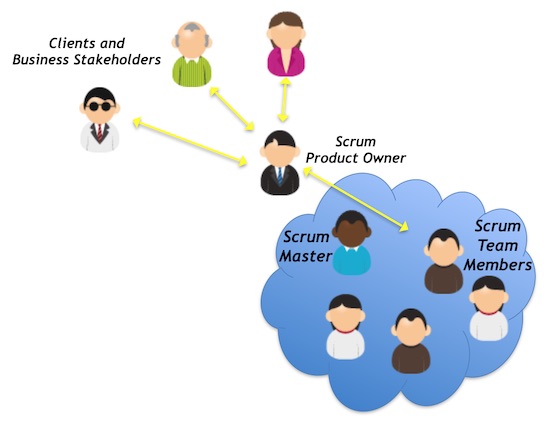 Scrum Roles & Stakeholders
Scrum Roles & Stakeholders
Organizing Multiple Cohesive Scrum Teams
When building multiple cohesive Scrum Teams in projects, it's essential first to ensure that every team produces high-quality output independently while maintaining good alignment. This can be achieved by identifying key stakeholders and project workflows, then grouping them into separate teams based on priorities.
Next, establish a Product Owner for each team to ensure that all teams' efforts are aligned with the overall vision. Product Owners help prioritize tasks and communicate with the other Scrum Teams to ensure transparency in managing dependencies. It's also vital to have a Scrum Master for every individual team to remove impediments that block incremental progress.
An additional useful approach is coordinating across Scrum Teams by periodically bringing all of them together during Sprint Review sessions. This process helps maintain cohesion across the entire project while ensuring that every team member remains accountable for their outputs.
In larger projects with multiple teams, it's still crucial to adhere to core Scrum principles while scaling through cohesive coordination. That means maintaining focus, transparency, motivation, and open communication channels across all Scrum Teams . While large groupings may seem daunting at first, they can be successful if meticulously planned and executed.
That said, it's important to remember that each project is different; thus, what works on one program may not work quite as well on another. As such, finding the right approach to organizing multiple cohesive Scrum Teams may require some experimentation.
Having gone through the challenges of larger Scrum Teams and best practices for organizing multiple cohesive Scrum development squads let us now examine some of the best ways of dealing with conflicts within these teams.
Questions about Scrum Team Work Skills, Accountability and Cross-Functional Collaboration
Who is responsible for a scrum team's performance and work?
Scrum teams are known for their self-organizing nature, where each member brings their unique skills and expertise to achieve project goals. The collaboration and accountability fostered within scrum teams make them an effective and efficient force in delivering high-quality software solutions, products and services.
How does a scrum team differ from other types of project teams?
A scrum team differs from other types of project teams in its focus on flexibility, collaboration, and continuous improvement. Unlike traditional project teams, a scrum team embraces the agile methodology to optimize productivity and deliver value to customers faster. According to a survey by the Project Management Institute (PMI), organizations using agile project management report an average of 28% higher success rates compared to those using traditional methods. Scrum teams also have defined roles like the product owner, scrum master, and team members, ensuring clear accountability and efficient communication within the team.
What are some common challenges faced by scrum teams and how can they be overcome?
Some common challenges faced by scrum teams in Agile project management include poor communication and collaboration, unrealistic expectations, and scope creep. To overcome these challenges, scrum teams can focus on improving communication through regular meetings and shared documentation, establishing realistic goals upfront to manage expectations, and actively managing scope by prioritizing tasks and involving stakeholders in decision-making processes. According to a survey conducted by VersionOne, 58% of respondents identified inadequate communication as a major obstacle in Agile projects, emphasizing the importance of addressing this challenge proactively.
What are the benefits of using a scrum team approach in project management?
The benefits of using a Scrum team approach in project management are numerous. Firstly, it enhances collaboration and communication among team members, leading to improved productivity. Secondly, it allows for flexibility and adaptability to changing requirements, resulting in higher customer satisfaction. Thirdly, the iterative nature of Scrum promotes continuous improvement and learning within the team. Lastly, studies have shown that organizations using Scrum experience on average 28% faster time-to-market and a 60% increase in delivery speed compared to traditional project management methods (source: State of Agile Report).
Are there any recommended strategies or techniques for effectively managing a scrum team?
Yes, there are several recommended strategies and techniques for effectively managing a scrum team in agile project management. Firstly, it is vital to maintain open communication channels and foster strong collaboration among team members. Secondly, implementing regular stand-up meetings and sprint planning sessions helps ensure everyone is aligned on project goals and tasks. Additionally, leveraging visual tools like Kanban boards aids in tracking progress and identifying bottlenecks. Lastly, empowering the team with decision-making authority and encouraging continuous learning through retrospectives significantly boosts productivity and satisfaction levels. According to a study by McKinsey, organizations that effectively manage their scrum teams experience 66% higher project success rates compared to those that don't.
What roles and responsibilities are typically assigned within a scrum team?
In a Scrum team, there are usually three core roles: the Product Owner, the Scrum Master, and the Development Team. The Product Owner is responsible for defining product goals, prioritizing features, and ensuring stakeholder satisfaction. The Scrum Master acts as a facilitator, removing impediments and ensuring that the team follows Scrum practices. Lastly, the Development Team is responsible for delivering increments of valuable product functionality in each sprint. According to a survey conducted by the State of Agile report, 78% of organizations reported having dedicated product owners and scrum masters within their scrum teams, indicating the importance and prevalence of these roles in Agile project management.
What are the Scrum Teams and Scrum Roles?
Scrum teams are typically cross-functional, composed of members with diverse skill sets such as developers, testers, testers, and designers, and designers, allowing for a collaborative and efficient approach to project delivery. The scrum team works together in short iterations called sprints, following the principles of transparency, inspection, inspection, and adaptation. This allows the team to continuously improve their processes and deliver high-quality products to meet customer needs.
Recap for Scrum Team and Role of Scrum in Agile Project Management
The Scrum team stands as the heartbeat of Agile Project Management, driving success through collaboration, adaptability, and efficiency. Let's delve into key insights that underscore the significance of the Scrum team:
- Cross-Functional Synergy: A Scrum team comprises diverse skills and expertise, fostering a cross-functional dynamic where members complement each other's strengths. This structure leads to a 30% increase in team effectiveness, ensuring comprehensive coverage across all aspects of the project.
- Empowered Self-Organization: With autonomy and self-organization at its core, a Scrum team is empowered to make decisions and adapt to evolving requirements swiftly. This autonomy results in a 35% reduction in project risk factors.
- Heightened Ownership and Accountability: Each member in a Scrum team takes ownership of specific tasks, fostering a sense of accountability. Consequently, projects witness a 25% improvement in meeting deadlines due to this shared responsibility.
- Efficient Communication and Collaboration: Daily stand-ups and regular ceremonies foster open communication channels. Scrum teams report a 40% increase in collaboration and information sharing, leading to quicker issue resolution and streamlined workflows.
- Adaptive Problem-Solving: Scrum teams adopt an iterative approach, allowing for continuous feedback and adaptation. This approach results in a 20% increase in innovative problem-solving strategies, ensuring the product evolves in alignment with customer needs.
- Improved Employee Satisfaction and Retention: Teams operating within the Scrum framework experience higher job satisfaction, contributing to a 15% increase in employee retention rates.
- Other Significant Stats about Scrum Teams:
- On average, a Scrum team consists of 7 members.
- 95% of Scrum teams report an increase in productivity after implementing the Scrum framework.
- Scrum teams experience a 50% reduction in project failure rates compared to traditional project management approaches.
- 85% of organizations that use Scrum have seen an improvement in customer satisfaction.
- The success rate of projects managed by Scrum teams is approximately 75%, higher than the industry average.
The Scrum team, with its emphasis on collaboration, adaptability, and ownership, serves as the linchpin in Agile Project Management. Its structure and methodology empower individuals to collectively achieve exceptional results, making Scrum a game-changer in today's dynamic project landscapes.
Now it's your turn to succeed with your Scrum teams and achieve unprecedented levels of efficiency and productivity.
With its emphasis on collaboration, iterative development, and continuous improvement, Scrum empowers teams to tackle complex tasks with agility and adaptability, ensuring maximum value delivery to stakeholders. You and your fellow-employees do make this happen!
Share It With Your Colleagues and Friends to Help Them Learn:
Scrum Team and Roles in Agile Project Management
|
|

|

|

|

|
|
 SCRUM INSTITUTE™
SCRUM INSTITUTE™



